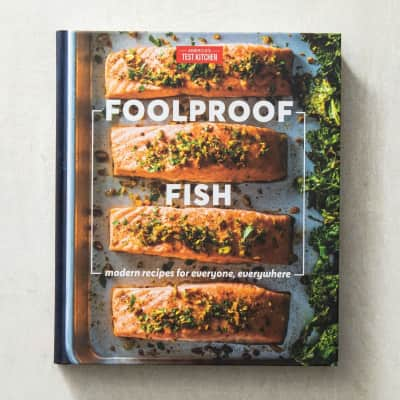Many of us peel shrimp before cooking it, but it’s time to rethink that habit. Not only does skipping peeling get you out of a tedious kitchen task but you’ll be preserving what is arguably the tastiest part of the crustacean.
Why You Should Keep the Shells on Your Shrimp
Published Feb. 14, 2023.

Sign up for the Notes from the Test Kitchen newsletter
Our favorite tips and recipes, enjoyed by 2 million+ subscribers!
What Are Shrimp Shells Made Of?
Shrimp shells are made of an elastic substance called chitin, which does not break down when heated. That means the shells do a great job of protecting lean, delicate shrimp flesh during cooking, helping to keep it juicy and tender.
We put this principle to work in our Garlicky Roasted Shrimp with Cilantro and Lime: Simply snip through the back of the shell with kitchen shears in order to devein the shrimp without removing the shell and then slide the shrimp under the broiler.
Foolproof Fish
Fresh, modern flavors, 175+ recipes that accommodate multiple kinds of fish, and plenty of fish facts will inspire you to dive into seafood cookery with confidence.What Are the Benefits of Cooking Shrimp in Their Shells?
Shrimp shells do more than just protect the flesh; they also significantly enhance its flavor in three ways:
- Shrimp shells contain water-soluble flavor compounds that are absorbed by the shrimp flesh during cooking, thereby enhancing its taste.
- The shells are also loaded with proteins and sugars—almost as much as the flesh itself. When they brown, they undergo the flavor-enhancing Maillard reaction just as roasted meats do, which gives the shells even more flavor to pass along to the flesh.
- Like the flesh, the shells contain healthy amounts of glutamates and nucleotides, compounds that dramatically enhance savory umami flavor when present together in food. These compounds also get transferred to the meat during cooking, amplifying the effect of the glutamates and nucleotides in the shrimp's flesh.
Can You Eat Shrimp Shells?
Many methods for cooking shell-on shrimp leave the shells tough and chewy (think shrimp boil). But some recipes feature a fried shell that’s entirely edible and as crispy and appealing to eat as the skin on fried chicken.
The rubbery texture of shrimp shells is caused by moisture, so to crisp the shells, it’s necessary to dehydrate them as much as possible. This is best accomplished by a very dry heat method like frying. In our Crispy Salt and Pepper Shrimp recipe, we toss shell-on shrimp in cornstarch before frying. The light, dry coating helps pull moisture from the shells. The moisture evaporates in the hot oil, leaving the shells brittle and crisp—and shockingly delicious.
Note: Since older, larger shrimp have thicker, tougher shells, it’s important to start with relatively small shrimp if you plan on consuming the shells; we prefer 31- to 40-count specimens.

